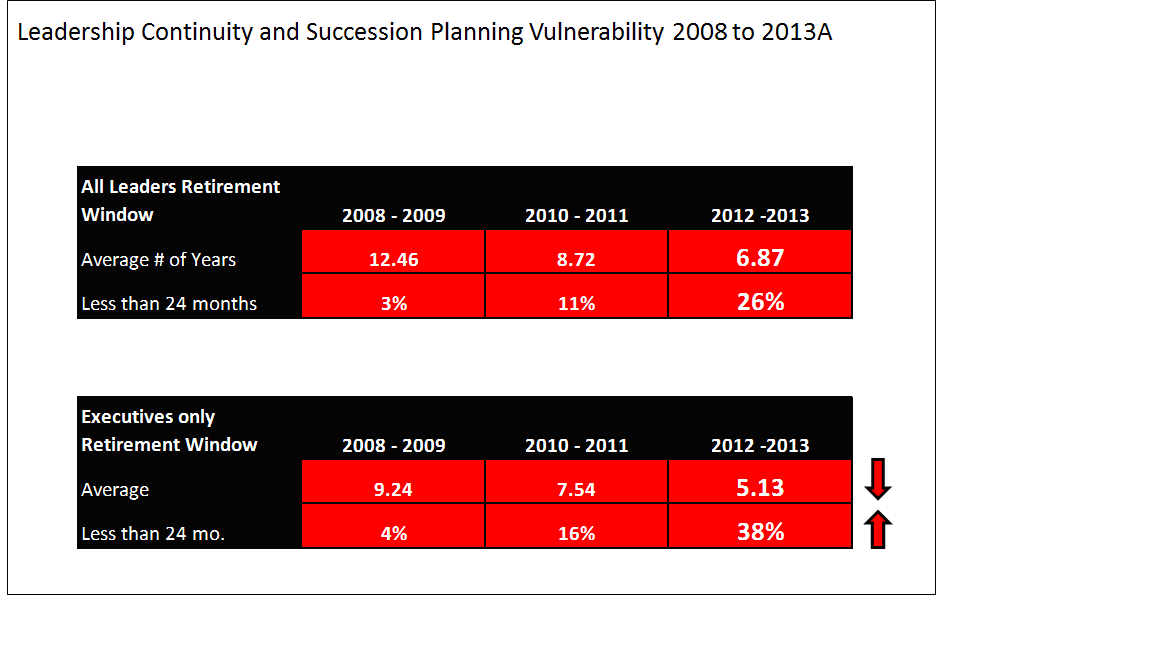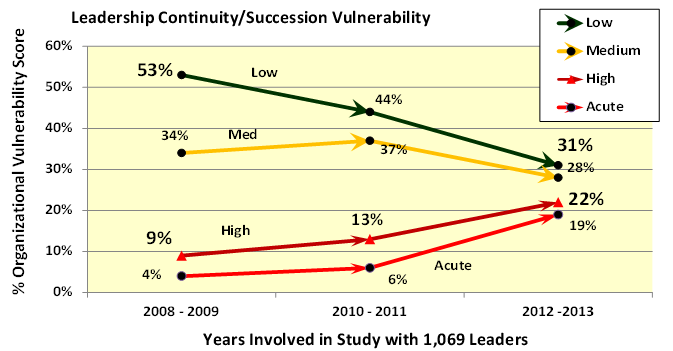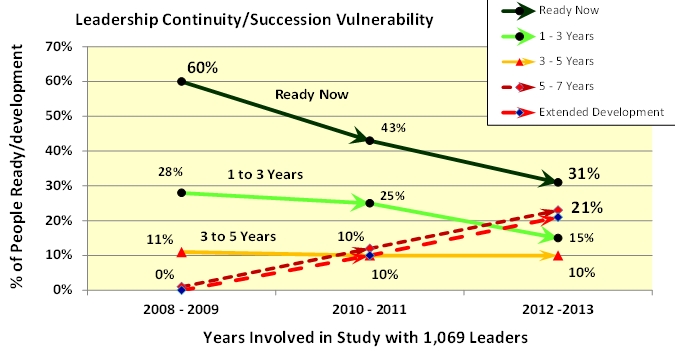How might the increase in struggling leaders impact succession planning vulnerability?
Hospital and health system leadership has experienced high levels of turnover in recent years. As leading healthcare organizations becomes more challenging, many leaders seek new opportunities or leave the field altogether. A study by Success Profiles, which was published by Becker's Hospital Review in March, supports the claim that healthcare leadership demands are growing increasingly complex. The study found that the number of leaders categorized as "struggling" — based on organization performance metrics — is significantly higher today three years ago.
Like many studies, the findings led to additional questions. One seemed particularly important: How might the increase in struggling leaders impact succession planning vulnerability?
To find out, we carried out a further study involving an analysis of our database, which includes leadership-effectiveness evaluations on more than 30,000 leaders. Our goal was to understand just what impact, if any, the increasing number of leaders who are now struggling may be having on leadership continuity.
Who will fill current healthcare leaders' shoes?
In order to explore succession planning in light of leadership complexity, we turned to data we gathered over six years on succession planning and continuity of leadership. The data was obtained through highly structured interviews during comprehensive talent management reviews with 1,069 leaders between 2008 and 2013.
For example, we investigated the following: the time to retirement window or expected length of time the present leader has in their current position; their span of control and the desire for specific opportunities by those being highlighted for advancement; and the state of readiness of candidates, their overall talent potential and the development times to prepare those candidates for future roles in leadership.
The interviews investigated every leadership role and utilized an algorithm to score each leader's leadership vulnerability, which is defined as the degree to which a particular role is susceptible to a leadership void. The level of vulnerability is then categorized as low, medium, high and acute.
1. Time-to-retirement among healthcare leaders shortening
It is well understood that the age demographic of current leaders indicates that many will be exiting healthcare leadership roles over the coming years. Almost 50 percent of members of the American College of Healthcare Executives are over the age of 50. Our analysis demonstrated the same trends: 26 percent of all leaders (executives, directors and managers) have less than 24 months until their retirement, and that figure increase to 38 percent for the executive-only group (see Diagram 1).
Diagram 1
2. Overall organizational leadership vulnerability on the rise
To form a baseline, we wanted to understand what was happening at an organizational level.
What we discovered was that previously low and medium levels of vulnerability have been declining since 2008, and high and acute levels of vulnerability were increasing. In fact, the combined scores of high and acute levels of vulnerability rose from 13 percent to 41 percent over the period of the study, and the lowest level of vulnerability fell from 53 percent to 31 percent (see Diagram 2). In other words, organizations overall are more susceptible to leadership voids.
It is likely that where there are high and acute levels of vulnerability that the only way to fill a vacancy would be to go outside the organization, which has both fiscal and time-lag implications. Additionally, during the period of vacancy, there will be the need for others to take up all or part of the responsibilities, adding to the complexity of other leaders in the organization.
Diagram 2
3. Interim vs. permanent appointments increasingly common
From 2008-2009, 87 percent of newly appointed healthcare leaders could immediately assume roles on a permanent basis. In other words, they were capable and ready to do so. For 2012-2013, this percentage had dropped to 40 percent, whilst the number of people who were not ready at all (in the time frame required) had risen from 5 percent to 27 percent.
We also measured those who would be unable to fill a role in a short term/interim fashion, and found this had increased from 7 percent to 22 percent.
4. Leadership roles increasingly must be split
For completeness, we also assessed whether a leadership role would need to be split due to factors such as the incumbent's span of control, which would simply be too great to be considered for just one individual to take over. The results (see Diagram 3; "yes" = split role, "no" = no split) show that the need to split a role is also increasing, which suggests leadership roles are indeed becoming more complex. This has various impacts, including additional financial demands on salaries and benefits.
Diagram 3
Additionally, role splitting is more prominent among executives (compared to directors and managers). Twenty-one percent (roughly 1 in 5) of roles will need to be split to allow new leaders to inherit a span of control for which they are prepared and ready, according to our analysis.
5. Leadership readiness for next role has dropped
"Bench strength" — or the readiness level of leaders — is also decreasing. When we investigated the state of readiness, including the development times required for individuals to fill leadership roles we discovered fewer individuals are ready immediately for a promotion to a more complex assignment (see Diagram 4).
In 2008-2009, 60 percent of individuals were ready immediately. By 2012-2013, this had fallen to 31 percent. The percentage of leaders requiring more than five years of development had risen to 44 percent from a base of 1 percent within the same time frame. We would hope these findings alone will generate serious debate, since if these trends continue, the situation is untenable. How can you run an effective high performing team if you do not have players that can fill vital roles when the need arises? The answer is simple. You can't.
Diagram 4
Summary
This analysis of leadership continuity and succession plan vulnerability point clearly at the dilemmas that healthcare is facing. Given the importance of healthcare, coupled with a more challenging leadership climate, how can future healthcare leaders be either developed or appointed into roles in which they can succeed?
Frank Pinkosky, executive vice president and chief human resource officer at The Guthrie Clinic in Sayre, Pa., says identifying future leaders early in their careers will become increasingly important. "We've also got to do a better job of identifying future talent from our emerging leaders," he says. "I have a strong belief we have more talent than we realize, but we're not identifying or taking advantage of that emerging talent yet."
Given the demographic of the current leadership group, it becomes even more concerning that our analysis finds a rapidly dwindling pool of readily available talent who can meet the demands of leadership.
If we were to agree that leadership has an effect on every single measure of delivery, including patient outcomes, patient experience, employee engagement, financial success and so on, why is it that the majority of Systems do not have formalized succession plans with every conceivable leadership base covered from the "bench"?
Perhaps the "urgent" is driving out the important?
Jon C. Cecil, FACHE, chief human resource officer at Lee Memorial Health System in Fort Myers, Fla., thinks a lack of urgency around succession planning is at play, despite its importance. "Could a contributor to this drop, besides the obvious aging demographics and increased complexity, be due to the fact many CEOs did not take succession planning seriously?" he wonders.
Yet, succession planning is a critical activity to ensure health system longevity. "Now, perhaps more than any other time in the history of healthcare delivery, it is vitally important for health care providers of all types to ensure we have strong leaders and managers in our organizations to help guide us through the challenging transition ahead," says, John Singerling, president of Columbia, S.C.-based Palmetto Health.
The solution is not about a piece of software; it is about a serious exercise of talent review of all potential leaders and engaging in succession planning, at least annually. The process will only succeed with CEO sponsorship and clear, non-negotiable elements from the start and relying upon data, not bias.
All healthcare organizations should consider the following questions:
- How often do you objectively measure the effectiveness of your entire leadership team (managers, directors, executives)?
- How vulnerable are you to unexpected departures? Do you have a five-year "future view" of your potential needs?
- Do you have a formalized succession planning strategy, which selects future leaders and provides a plan to develop their talents and capabilities to meet future demands and time frames and review this openly at board level?
- How would do you rate your bench strength?
- How well do you understand the financial and disruption implications of hiring from the outside vs. hiring from the inside?
Tom Olivo is the founding partner in the consulting firm Healthcare Performance Solutions and the president of Success Profiles, Inc. Established in 1990, Success Profiles designs and provides organizational performance measurement instruments and database management services to clients, management consulting firms and professional associations. In his professional career, Mr. Olivo has over 25 years of experience in identifying, measuring and comparing the “commonalities” of highly successful athletes, business leaders and organizations. He has worked in a multitude of industries with thousands of senior executives and managers, emphasizing the importance of business analytics and getting the right people in the right roles.


